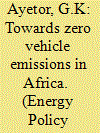|
|
|
Sort Order |
|
|
|
Items / Page
|
|
|
|
|
|
|
| Srl | Item |
| 1 |
ID:
177500


|
|
|
|
|
| Summary/Abstract |
This paper reviews vehicle standards in Ghana and other parts of Africa. The paper also considers the cost of ownership of electric vehicles in Ghana. Tesla Model 3, Tesla Model S, Nissan Leaf and Toyota Prius are compared to Toyota Corolla. The parameters considered are initial cost, maintenance cost (spare parts and labour), fuel cost, and availability of skilled labour. Considering Ghana's energy mix, a conventional vehicle will emit 3.35 times more CO2 emissions compared with an electric vehicle. The results show that while there are 30% savings on cost per mile for Toyota Prius it cost at least 13.5% more to own an electric vehicle compared to Toyota Corolla. The Ghana government's tax incentive for removing import levy will only reduce the cost per mile by 2.5%. Ghana's energy surplus of 98.59 GWh is enough to charge at least 1.5 million electric vehicles. But a huge skills gap in electric vehicle maintenance, non-availability of spare parts, charging infrastructure and the initial price of electric cars are the main challenges to overcome to boost electric vehicle penetration in Ghana and other countries in Africa.
|
|
|
|
|
|
|
|
|
|
|
|
|
|
|
|
| 2 |
ID:
168298


|
|
|
|
|
| Summary/Abstract |
Current research on the driving performance and energy consumption of electric vehicles (EVs) and plug-in hybrid electric vehicles (PHEVs) considers several criteria, including electric reachability, load to the electric grid, and the share of distances that can be driven electrically. However, prior studies do not distinguish between different driver segments but treat the entirety of drivers as a coherent whole. These aggregated results are hence limited to a macro-level perspective or to an isolated assessment of the recruited driver sample, which reduces the validity of forecasts with respect to specific groups of adopters and their regional impact to the grid. In contrast, the present study outlines a procedure for a segment-wise analysis of drivers using GPS mobility data. The proposed approach allows for both, comparative usability analyses between distinct groups and predictions of the load to the electrical grid on a segment-by-segment basis. We illustrate our approach by the example of a dataset collected from 982 drivers in Italy over two years. The results support decision makers regarding the identification of segment-specific vehicle and infrastructure requirements. Moreover, the insights about benefits and obstacles of EV and PHEV adoption per segment help users take more informed purchasing decisions.
|
|
|
|
|
|
|
|
|
|
|
|
|
|
|
|
| 3 |
ID:
150664


|
|
|
|
|
| Summary/Abstract |
With almost $1 billion in funding, Better Place was poised to become one of the most innovative companies in the electric mobility market. The system Better Place proposed had two novel prongs; first, to reduce the cost of batteries, and second, to reduce range anxiety, public infrastructure concerns, and long charging times. Yet, despite this seemingly strong combination, Better Place failed to make any progress in Denmark and Israel, the first two markets it operated in, and subsequently declared bankruptcy, selling off its collective assets for less than $500,000. Drawing from science and technology studies and the notion of “interpretive flexibility,” this paper posits several reasons to explain the failure of Better Place, including that Denmark is not as “green” as it seems nor is the Israeli market as attractive as believed, and that Better Place's solution to charging time and range anxiety resolved a psychological, not a functional, barrier of the general public to adopt electric vehicles. Before investigating these two reasons, the paper presents a short history of Better Place and explores the contours of its operations in Denmark and Israel. It then discusses why Better Place “failed” across both countries before concluding with implications for energy planning, policy, and analysis.
|
|
|
|
|
|
|
|
|
|
|
|
|
|
|
|
|
|
|
|
|